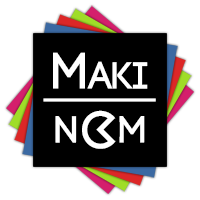A quick overview over the project and setting up the basics of the breakout game.
This game tutorial series will teach you how to create a simple match 3 game. The player swaps 2 jewels, if afterwards 3 or more jewels match, they’ll be destroyed (giving points) and the jewels above will fall down, possibly creating additional matches.
In this tutorial we’ll set up the Unity project, take a quick look at the project and set up some basics in the Makinom editor.
Setting up the Unity Project #
By now you should’ve downloaded the project resources, a unitypackage file containing the assets we’ll use in this tutorial series.
Create new Unity Project #
Use the Unity Hub to create a new Unity project, make sure to use at least Unity 2019.1, best one of the LTS versions (e.g. Unity 2019.4 LTS).
The new project comes with an empty sample scene set up, we don’t really need it, so you can delete it (and the folder Assets/Scenes/) if you want.
We’ll use the Unity UI module, make sure the project contains the TextMesh Pro and Unity UI packages. They should automatically be included in a new Unity project, if not, use the package manager (Window > Package Manager) to import them.
Importing Resources and Makinom #
Next, we’ll import the project resources you’ve downloaded and the latest Makinom 2 version (or any you’ve got lying around).
The order in which you import them doesn’t matter. If you get a warning regarding script updates, confirm it to continue with the import.
The tutorial resources can be found in this folder: Assets/Tutorial Resources/
All our setup will be done in the Level 1 scene (found at Assets/Tutorial Resources/Scenes/), so you can already open it.
Setting up Makinom #
We’ll now set up some basics in the Makinom project. Open the Makinom editor (Window > Makinom) – this will create a new Makinom project at Assets/Gaming Is Love/_Data/Project.asset, in case no project has been created or opened yet.
Game Object Pools #
We’ll use pooling to reduce the amount of game objects created and destroyed during the game – you can learn more about pooling in this documentation.
Whenever a jewel is destroyed, a particle effect will be spawned at it’s position, we’ll use pooling to reduce the costs for creating and destroying these short-lived game objects.
Navigate to Base/Control > Game Object Pools and change the following settings in the Default pool.
0: Destroy Particles #
- Name
Set to Destroy Particles. - Prefab
Select Destoy Particles.
The prefab can be found at Assets/Tutorial Resources/Prefabs/. - Start Size
Set to 20. - Can Grow
Enable this setting.
UI System #
We’ll use the Unity UI module – it’s best to select the UI system as one of the first things when starting a new project.
Navigate to UI > UI System and change the following setting.
UI System Settings #
- UI System Type
Select Unity UI. - Default Screen Size
Set to X=1280, Y=720.
You should also change the resolution of your Unity project to use the same size.
You can find them in Edit > Project Settings… > Player, they’re available when not using fullscreen mode.
Changing the UI system will show confirmation dialogue, which we’ll accept via the Ok button.
And that’s it – click on Save Settings (and on Confirm in the following screen) to save the changes.
Scene Setup #
Finally, we’ll add Makinom to the scene. Open the Level 1 scene (found at Assets/Tutorial Resources/Scenes/).
Adding a Game Starter #
To add Makinom to the game, we’ll need a game starter. You can learn more in the game starters documentation.
Add the game starter using the scene wizard (Window > Makinom Scene Wizard). Click on Add Game Starter, select the Makinom project if it’s not already selected (found at Assets/Gaming Is Love/_Data/Project.asset) and click on Add Game Starter again. The scene wizard will create a new game object and attach the game starter to it.
Move the new game starter object out of the way, e.g. to X=-10, Y=0, Z=0.
Adding the Pool #
Again, we’ll use the scene wizard to add the game object pool we set up: Create Object > Pool
Move the new pool object out of the way (e.g. X=-10, Y=-1, Z=0) and change the following settings in the inspector of the Pool component.
- Pool
Select Destroy Particles.
And that’s it for now – save the scene.
The next tutorial will handle the UI setup.





